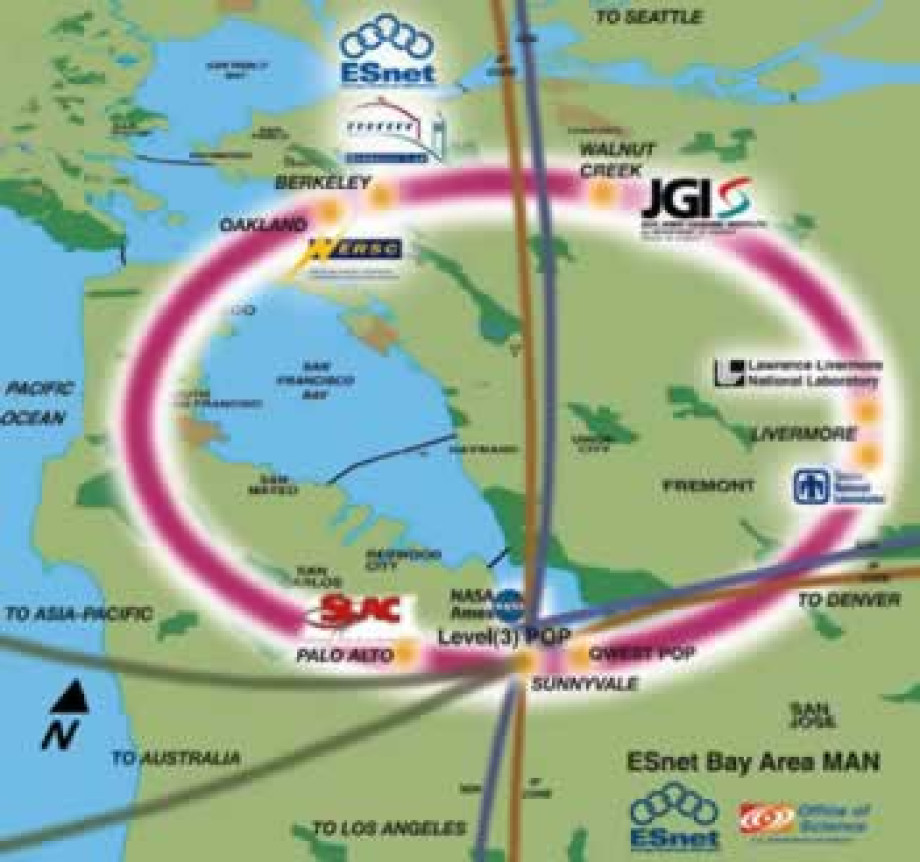ESnet Update: Hardware Upgrades to Regional Network Sites

BAMAN Upgrades Completed: The new routers enable ESnet engineers to accurately monitor traffic flows and seamlessly deliver OSCARS virtual circuits from the Science Data Network backbone across the metropolitan area network.
Contact: Linda Vu | lvu@lbl.gov
Throughout February and March, ESnet engineers continued to upgrade hardware and network capabilities at its regional network sites across the country.
Upgrades to the Bay Area Metropolitan Area Network (BAMAN) were completed earlier this month when Cisco routers at NERSC’s Oakland Scientific Facility and the Joint Genome Institute in Walnut Creek were replaced with hardware from Juniper’s MX series. The new routers enable ESnet engineers to accurately monitor traffic flows and seamlessly deliver OSCARS virtual circuits from the ESnet4 Science Data Network (SDN) backbone across the metropolitan area network. OSCARS is a networking protocol developed by engineers at ESnet that allows researchers to reserve guaranteed bandwidth on the network to transfer large volumes of scientific data, or time-sensitive information, anywhere in the world. The BAMAN upgrades also allow for the cost-effective scaling of additional 10-gigabit lines in the future.
The Chicago Metropolitan Area Network was also enhanced as new MX960 and MX480 routers were installed at the Fermi National Accelerator Laboratory (Fermilab). The same series routers are currently being installed at Brookhaven National Laboratory (BNL), and the final MX960 upgrade is planned for Argonne National Laboratory in April. These upgrades provide redundant hardware for greater availability and trouble-free bandwidth additions. Each 10-gigabit line is capable of transferring the equivalent of 500 hours of digital music per second, which is essential for connecting DOE researchers to large science experiments like the Large Hadron Collider (LHC).
“Just like past ESnet4 IP and SDN rollouts, the BAMAN and remote site upgrades were successful due the intense pre-planning and coordination done by the ESnet engineering staff. Detailed steps were taken to make sure that very limited, and in most cases, no production traffic interruptions were seen to the sites’ Internet connectivity,” says Jim Gagaliardi, Computer Systems Engineer Technical Lead for ESnet’s Operations and Deployment Group.
The Long Island Metropolitan Network (LIMAN) received two new 10-gigabit waves between ESnet hubs in New York City and BNL. Meanwhile, an additional 10-gigabit wave was added between the hubs in New York City. This doubles the LIMAN capacity from 20 to 40 gigabits. This new capacity was added in preparation for the increased data flows from the LHC and Relativistic Heavy Ion Collider (RHIC) programs at BNL.
In February, one new 10-gigabit connection was added between the ESnet hub in Boston and the Massachusetts Institute of Technology (MIT). This gives researchers at MIT a connection to the ESnet IP backbone and a direct path to the SDN hub in New York City.
Lastly, a new DS3 circuit to the Oak Ridge Associated Universities (ORAU) in Tennessee provides a backup connection to Washington, D.C. This will give ORAU a backup path to ESnet if the primary path were to go down. This install occurred in this month.



